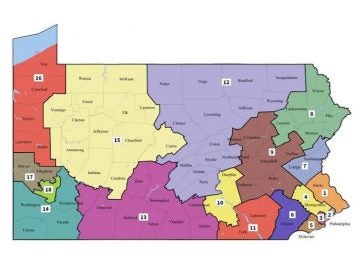Gerrymandering lawsuits linger as next redistricting nears
A year of legal battles is beginning over lingering allegations that electoral districts across the country were illegally drawn to the disadvantage of particular voters.

Hundreds pack the auditorium of Upper Dublin High School for a discussion of gerrymandering hosted by the group Fair Districts Pa. (Dave Davies/WHYY)
As the 2019 state legislative sessions get underway, a busy year of legal battles also is beginning over lingering allegations that hundreds of electoral districts across the country were illegally drawn to the disadvantage of particular voters or political parties.
First up was a court hearing Thursday in Virginia, where a federal judicial panel reviewed several proposals from an outside expert to redraw some state House districts. The court had previously determined that those districts were racially gerrymandered.
The expert, University of California, Irvine political science professor Bernard Grofman, answered questions about his revisions.
“My focus was on remedying constitutional infirmities,” he said.
Next on the schedule is a February trial in Michigan, where a lawsuit by Democratic voters alleges U.S. House and state legislative districts were illegally gerrymandered by Republican officials to dilute the voting power of Democrats. A similar partisan gerrymandering trial is scheduled for March involving Ohio’s congressional districts.
The U.S. Supreme Court also has agreed to hear arguments in March on separate cases appealing rulings of unconstitutional partisan gerrymandering of congressional districts by Republicans in North Carolina and Democrats in Maryland.
Then a new trial is scheduled for April in Wisconsin in a case in which federal judges previously determined that Republicans had illegally gerrymandered the state Assembly districts to the disadvantage of Democrats.
The pending lawsuits are contesting districts drawn based off 2010 Census data. They seek to force new district boundaries before the next legislative elections. But depending on the timing and scope of the rulings, they also could set precedents for states to follow during the next round of mandatory redistricting that will occur after the 2020 Census.
Here’s a state-by-state look at the pending redistricting cases, as well as some that were recently decided by the courts:
—
Alabama
Partisan breakdown: U.S. House: six Republicans, one Democrat.
The claim: Racial gerrymandering.
The case: A federal lawsuit filed last June and backed by a national Democratic redistricting group alleges the U.S. House maps approved in 2011 by the state’s Republican-led Legislature and GOP governor illegally limit the voting influence of black residents.
A separate lawsuit previously alleged that state House and Senate maps had packed too many black voters into certain districts. The U.S. Supreme Court in 2015 ordered those maps to be reconsidered by a lower court, which subsequently struck down a dozen districts. The Legislature then redrew 25 of the 35 state Senate seats and 70 of the 105 state House seats. The court dismissed a challenge to the new maps in October 2017.
—
Arkansas
Partisan breakdown: U.S. House: four Republicans.
The claim: Racial gerrymandering.
The case: A federal judicial panel in August ruled that the publisher of the Little Rock Sun, a black community newspaper, did not have legal standing to bring a lawsuit alleging the boundaries of an eastern Arkansas congressional district were drawn to dilute the voting strength of black residents. The U.S. Supreme Court dismissed an appeal Dec. 10. Democrats controlled both the Legislature and governor’s office during the 2011 redistricting.
—
Connecticut
Partisan breakdown: State Senate: 24 Democrats, 12 Republicans; State House: 92 Democrats, 59 Republicans.
The claim: Prison gerrymandering.
The case: A federal lawsuit filed last June by the NAACP alleges unconstitutional prison gerrymandering in the drawing of state House and Senate districts. It challenges the state’s decision to count prisoners as residents of the district where they are incarcerated instead of their home districts. The suit says prisoners are disproportionately black and Latino and from urban areas, but they are often placed in prisons in rural areas predominated by white residents. The districts were drawn in 2011 by a bipartisan commission.
—
Georgia
Partisan breakdown: U.S. House: nine Republicans, five Democrats. State House: 103 Republicans, 75 Democrats, two seats vacant pending the outcome of special elections.
The claim: Racial and partisan gerrymandering.
The cases: A federal lawsuit filed last June and backed by a national Democratic redistricting group alleges that a U.S. House district was redrawn in 2011 by the state’s Republican-led Legislature and GOP governor to illegally limit the voting influence of black residents.
A separate federal case filed in 2017 by the NAACP and Democratic voters alleges that two state House districts were unconstitutionally gerrymandered by the Republican-led Legislature in 2015 to increase the percentage of white voters and decrease the percentage of black voters. In September, a federal judicial panel allowed the plaintiffs to add a partisan gerrymandering claim to the lawsuit.
—
Louisiana
Partisan breakdown: U.S. House: five Republicans, one Democrat.
The claim: Racial gerrymandering.
The case: A federal lawsuit filed last June and backed by a national Democratic redistricting group alleges the U.S. House maps approved in 2011 illegally limit the voting influence of black residents by packing a large number into one majority-minority district and spreading other black voters out among multiple districts. Republicans controlled both legislative chambers and the governor’s office at the time the redistricting plan was approved during a special legislative session.
—
Maryland
Partisan breakdown: U.S. House: seven Democrats, one Republican.
The claim: Partisan gerrymandering.
The case: The U.S. Supreme Court has scheduled arguments in March on an appeal of a ruling that western Maryland’s 6th Congressional District is an unconstitutional partisan gerrymander that diluted the voting power of Republicans. Democratic Attorney General Brian Frosh appealed a Nov. 7 federal court order to redraw congressional districts by March 7 using traditional redistricting criteria that show regard for “natural boundaries.”
The 6th District had been held by a 20-year Republican incumbent. But the Democratic governor and Democratic-controlled Legislature redrew it in 2011 to extend into suburban Washington, D.C., adding tens of thousands of Democratic voters while dropping Republican voters. Democrats have won the district in each election since then. While the case is pending, Republican Gov. Larry Hogan has created a nine-member commission to recommend new congressional district boundaries to his office by April. The revised map then would be submitted to the Legislature for a vote.
—
Michigan
Partisan breakdown: U.S. House: seven Republicans, seven Democrats. State Senate: 22 Republicans, 16 Democrats. State House: 58 Republicans, 52 Democrats.
The claim: Partisan gerrymandering.
The case: A federal trial is scheduled to begin Feb. 5 on a lawsuit by Democratic voters alleging that Michigan’s U.S. House and state legislative districts are unconstitutionally gerrymandered to dilute the voting power of Democrats. The districts were enacted in 2011 by a Republican governor and Republican-led Legislature. Voters approved a constitutional amendment in the November elections creating an independent commission to handle redistricting after the 2020 Census.
—
North Carolina
Partisan breakdown: U.S. House: nine Republicans, three Democrats, with one race undecided. State Senate: 29 Republicans, 21 Democrats. State House: 65 Republicans, 55 Democrats.
The claims: Partisan and racial gerrymandering.
The cases: The U.S. Supreme Court has scheduled arguments for March on an appeal of an August federal court ruling that the Republican-led state legislature engaged in unconstitutional partisan gerrymandering when it redrew congressional districts in 2016. (Lawmakers were redrawing the districts in response to a previous court ruling that some 2011 districts were an unconstitutional racial gerrymander.) In October, the federal court delayed its order to redraw the maps again pending an appeal to the U.S. Supreme Court.
Separate lawsuits also have challenged state House and Senate districts. A federal court ruled in 2016 that 28 state legislative districts were unconstitutional racial gerrymanders. The legislature redrew the districts the next year, and federal judges in early 2018 required additional changes. On Nov. 2, a state judicial panel struck down four of those redrawn House districts, ruling that it wasn’t necessary to change them to comply with the earlier rulings. On Nov. 13, the state Democratic Party and other plaintiffs filed a new lawsuit in state court contending the state’s House and Senate districts are partisan gerrymanders that disadvantage Democratic voters in violation of the state constitution.
—
Ohio
Partisan breakdown: U.S. House: 12 Republicans, four Democrats.
The claim: Partisan gerrymandering.
The case: A federal trial is scheduled to begin March 4 on a lawsuit by Democrats alleging that unconstitutional partisan gerrymandering has disadvantaged Democratic voters in Ohio’s U.S. House districts. The districts were enacted in 2011 by a Republican governor and Republican-led Legislature. Voters approved a constitutional amendment last May revamping the redistricting process. It will require a bipartisan vote of legislators or special commissioners to enact congressional districts that would remain in effect for a full decade after the 2020 Census. If lawmakers don’t reach a bipartisan threshold, then the new districts could only last for four years.
—
Pennsylvania
Partisan breakdown: U.S. House: nine Republicans, nine Democrats.
The claim: Partisan gerrymandering.
The case: The Pennsylvania Supreme Court ruled in January 2018 that the U.S. House districts enacted in 2011 by a Republican governor and GOP-led Legislature were an unconstitutional partisan gerrymander favoring Republicans. The court in February imposed new district boundaries, which were used in the November elections. Under the GOP-drawn maps, Republicans held a 13-5 majority over Democrats in Pennsylvania’s congressional delegation for three straight elections, despite Democrats having more registered voters. Under the new map, Democrats and Republicans each won nine congressional seats in last November’s elections.
—
Texas
Partisan breakdown: U.S. House: 23 Republicans, 13 Democrats. State House: 83 Republicans, 67 Democrats.
The claim: Racial gerrymandering.
The case: U.S. and state House maps enacted in 2011 by the Republican governor and GOP-led Legislature were tossed out in 2012 by a federal court, which produced new interim maps. Those maps were permanently adopted by the Legislature and governor in 2013. But in 2017, the federal court ruled that some districts were racially gerrymandered to weaken the electoral power of growing minority populations. The U.S. Supreme Court largely overturned that decision last June, striking down only one state House district in Fort Worth. A lower court has deferred redrawing that district to allow time for the Legislature to do so during the 2019 session.
—
Virginia
Partisan breakdown: State House: 51 Republicans, 49 Democrats.
The claim: Racial gerrymandering.
The case: A federal judicial panel ruled last June that 11 state House districts were unconstitutional racial gerrymanders, finding that lawmakers in 2011 had packed black voters into certain districts so that surrounding ones would have more white and Republican voters. In December, a court-appointed expert submitted potential revisions affecting between 21 and 26 districts. A court hearing on those recommendations was held Thursday. Meanwhile, the U.S. Supreme Court has agreed to hear an appeal of the case some time in 2019. Virginia’s legislative primaries are scheduled for June 11.
In a previous case, a federal court in January 2016 redrew congressional districts after ruling that black voters had been illegally packed into a particular district to diminish their voting strength elsewhere. Republicans, who previously held an 8-3 majority in Virginia’s congressional delegation, dropped to a 7-4 majority after the 2016 elections. Democrats also won a 7-4 majority in the 2018 elections.
—
Wisconsin
Partisan breakdown: State Assembly: 63 Republicans, 36 Democrats.
The claim: Partisan gerrymandering.
The case: A new federal trial is set to begin April 23 on a partisan gerrymandering lawsuit involving the state Assembly. The U.S. Supreme Court in June overturned a November 2016 lower court ruling that had struck down Wisconsin’s state Assembly districts as an unconstitutional partisan gerrymander. The lower court had said the map adopted in 2011 by the Republican-led Legislature and Republican governor violated Democratic voters’ rights to representation by packing Democrats into some districts and spreading them among others, thus diluting their voting power.
The U.S. Supreme Court said plaintiffs failed to prove they had the right to sue on a statewide basis. It sent the case back to the lower court for plaintiffs to attempt to prove that their personal voting rights were infringed by the way particular districts were drawn.
—
Associated Press writer Denise Lavoie in Richmond, Virginia, contributed to this report.
WHYY is your source for fact-based, in-depth journalism and information. As a nonprofit organization, we rely on financial support from readers like you. Please give today.




